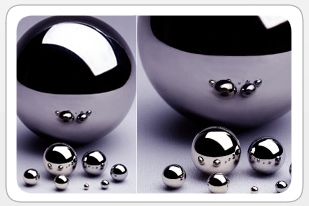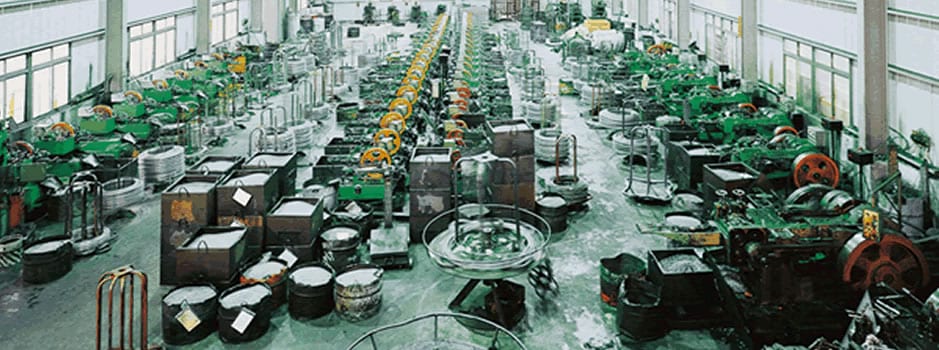



Selecting the proper media for grinding and milling operations is essential. Grinding media is used in these processes to grind or crush material to both reduce particle size and refine material. Grinding media is available in a broad variety of materials, shapes, and sizes. Which media is appropriate depends on the specifics of the intended application.
Mixing, crushing, dispersing, and purifying variable materials generally requires some type of grinding media ball or bead. Various properties influence how the work material is processed and how long the media can be used for. Many facets of grinding media can be customized, such as:
STR Industries is a professional ball manufacturer, and we have been manufacturing media for 30 years. We are TS 16949(auto industry standard, higher than ISO 9001) certified. Our 200,000 square foot facilities produce more than 400 metric tons of balls per month. Our product sizes range from 0.8mm to 80mm in chrome, carbon, stainless steel, plastic, and ceramic materials.
Our grinding media is approved by customers not only in the ink but also pigment, paste, ferrite, and food industries. We have been providing customers worldwide directly with our products, saving a substantial amount of money. If you are not sure what media you need, we offer free consultations to make sure you get the perfect product for your operation. Our team includes experienced ceramic, mechanical, and electrical engineers who are happy to lend their expertise and help solve any challenges you might face. We utilize state-of-the-art diamond grinding and precision measuring capabilities to ensure every part meets the tightest tolerances. Whether you need an existing solution adapted or a completely new product developed, you can rely on us for guidance and support every step of the way.
Ceramic media is ideal for applications that call for highly efficient grinding with low grinding media abrasion. With a hardness rating of 9+ on the Mohs scale, second only to diamond, ceramic media delivers exceptional resistance to wear from sliding abrasion or erosion. This means you can count on consistent performance and longevity, making it a top choice for demanding grinding environments where durability and efficiency are key. Applications where mixing and dispersing effects impact the final outcome of a project will benefit from the use of ceramic media.
While steel media is common for grinding in many instances, it cannot be used to manufacture bright colors. Contamination from the steel is also an issue for some product types.
Ceramic beads present a number of benefits, such as:
At STR, we offer grinding media with ceramic materials such as:
Our ceramic media is produced in facilities certified to internationally recognized ISO 9002 quality standards. Each batch benefits from precision diamond grinding and advanced finishing technologies, ensuring exceptionally tight tolerances for even the most demanding applications.
Additionally, our experienced team of ceramic, mechanical, and electrical engineers is available to collaborate with you—offering technical expertise and hands-on support, whether you’re troubleshooting a process or seeking guidance for a specialized project.
Structural ceramics excel in applications where absolute impermeability is a requirement. These materials are engineered to prevent the passage of both liquids and gases—making them an excellent choice for use in demanding hermetic environments. Their dense, non-porous structure provides complete resistance to fluid and gas infiltration, ensuring reliable performance in critical sealing or containment applications.
Zirconia is used in grinding media, cutting tools, jewelry, refractory materials and a variety of other applications due to beneficial physical properties such as high hardness, strength, toughness, excellent wear resistance, electrical conductivity, and low thermal conductivity.
These formulations are also essential for processes like deagglomeration, mixing, and particle size reduction—making zirconia a go-to material in industries ranging from electronics and minerals to floor and wall tile, sanitaryware, tableware, and paints and coatings. Advanced diamond grinding and precise measuring enable the production of tightly toleranced zirconia parts, ensuring consistency and reliability in demanding applications. With the support of multidisciplinary engineering teams, zirconia-based products can be tailored for unique performance requirements across a broad spectrum of technical and industrial uses.
Structural ceramics are renowned for their ability to maintain mechanical stability even under extremely high temperatures. Unlike many materials that weaken or deform, these ceramics show no cold flow and retain their strength when continuously used at temperatures exceeding 2000°F (1093°C). In some scenarios, they can even withstand intermittent spikes up to 3000°F (1649°C) without suffering permanent damage. This remarkable resistance to heat makes them an excellent choice for applications demanding long-term durability in high-temperature environments.
Zirconia beads make the best use of the structural properties in specific characters of zirconia. The various classifications of zirconia include:
Featuring high density and exceptional hardness, Yttria Stabilized Zirconia Beads ZY offer higher productivity, longer mill life, and lower long-term operational costs. These 100% round and uniform beads are available in sizes ranging from 0.1–2.7 mm.
Ceria Stabilized Zirconia Beads CZ offer the highest density, optimized wear resistance, and cost effectiveness as an efficient milling media. Available sizes range from 0.3–2.7 mm, and these beads are also guaranteed to be 100% round and uniform.
| Composition | Density g/cm3 | Bulk Density kg/l | Hardness Hv | Color | |
|---|---|---|---|---|---|
| ZY | ZrO2 / Y2O3 | >6.02 | > 3.7 | >1350 | Ivory |
| CZ | ZrO2 / CeO2 | >6.20 | > 3.9 | >1250 | Brown |
| Composition | Density | Bulk Density | Hardness | Color | |
|---|---|---|---|---|---|
| Steel | See steel info | 7.8 | 4.9 | 60-65 RC | Silver |
| Glass | SiO2 | 2.5 | 1.6 | Transparent | |
| Alumina | Al2O3 | 3.8 | 2.2 | 1600 Hv | White |
| Zircon | ZrSiO4 | 3.8 | 2.4 | 1000 Hv | White |
| ZY | ZrO2+Y2O3 | 6 | 3.6 | 1300 Hv | Ivory |
| CY | ZrO2+CeO2 | 6.2 | 3.8 | 1200 Hv | Brown |
Aluminum oxide is known for its high strength and surface area properties, along with corrosion and heat resistance. In addition to fending off rust, it stands up impressively well against a wide range of harsh substances—corrosive liquids, acids, alkalis, organic solvents, molten salts, and even molten metals rarely make a dent. This robust resistance makes aluminum oxide a popular choice in environments where lesser materials would quickly succumb to chemical attack.
| AISI Number | C % | Si % | Mn % | Mo % | P % | S % | Hardness |
|---|---|---|---|---|---|---|---|
| AISI 1008 | 0.10 Max | 0.30 Max | 0.50 Max | 0.012 | 0.07 Max | 0.06 Max | Case Hardened HRC 55Min |
| AISI 1015 | 0.13~0.18 | 0.10~0.30 | 0.30~0.60 | 0.02 | 0.04max | Case Hardened HRC 55~61 |
|
| AISI 1045 | 0.43~0.50 | 0.10~0.30 | 0.60~0.90 | 0.025 | 0.04 Max | 0.05 Max | Through Hardened HRC 60 Min |
| AISI 1086 | 0.83~0.88 | 0.10~0.30 | 0.30~0.70 | 0.04 | 0.04 Max | 0.04 Max | Through Hardened HRC 60 Min |
Chemical Composition
3 ~ 1000
1.0mm~ 2″
Casters, bicycle parts, light-duty bearing, hardware, toy and etc.
| C % | Si % | Mn % | Cr % | Cu % | S % | P % |
|---|---|---|---|---|---|---|
| 0.90~1.05 | 0.15~0.35 | 0.25~0.45 | 1.35~1.65 | 0.3 Max | 0.03 Max | 0.03 Max |
Chemical Composition
7.84 g/cm3
Through hardened, HRC 60 Min. Grade
5~ 1000 grade
0.5mm~5″
Bearing, Ball Screw, Linear motion guide, Auotomotive parts, Chemical, food processing.
| AISI Number | C % | Si % | Mn % | Cr % | Ni % | Mo % | P % | S % | Character |
|---|---|---|---|---|---|---|---|---|---|
| AISI 302 | 0.15 Max | 1.00 Max | 2.00 Max | 17.0~ 19.0 | 8.0~ 10.5 | 0.045 Max | 0.03 Max | Slightly magnetic Austenitic |
|
| AISI 304 | 0.07 Max | 1.00 Max | 2.00 Max | 17.0~ 19.0 | 8.50~ 10.5 | 0.045 Max | 0.03 Max | Slightly magnetic Austenitic |
|
| AISI 316 | 0.07 Max | 1.00 Max | 2.00 Max | 16.5~ 18.5 | 10.5~ 13.5 | 2000~ 2.50 | 0.045 Max | 0.03 Max | Nonmagnetic Austenitic Excellent corrosion resistance |
| AISI 420J | 0.17~ 0.25 | 1.00 Max | 1.00 Max | 12.0~ 14.0 | 0.045 Max | 0.03 Max | Magnetic Hardenable HRC 48 Min fair corrosion resistance |
||
| AISI 430 | 0.08 max | 1.00 Max | 1.00 Max | 15.5~ 17.5 | 0.045 Max | 0.03 Max | Fair- good corrosion resistance |
||
| AISI 440C | 0.95~ 1.20 | 1.00 Max | 1.00 Max | 16.0~ 18.0 | 0.40~ 0.80 | 0.04 Max | 0.02 Max | Fair corrosion resistance Hardenable HRC 58 Min |
Chemical Composition
10~1000
0.5mm~2″
Dispenser valve ball, stainless steel bearing, chemical related application
Some of the industries that rely on ceramic grinding media include:
Ceramic grinding media also play a vital role in several other sectors, such as:
These industries depend on the unique properties of ceramic grinding media for everything from achieving the right particle size in pigments to producing durable tiles and high-performance electronic components.
In addition to ceramic media, we also offer a selection of metallic grinding media. Balls may be made of carbon steel, glass, chrome steel, or stainless steel and range from 0.8–80 mm.
Our grinding media is subjected to a variety of production and inspection processes before being sent to the customer, such as:
STR Industries has been manufacturing media of various types for 30 years and we are TS 16949 certified for quality assurance. We operate more than 200,000 square feet of facility space that produces more than 400 metric tons of balls per month. Our grinding media is used by customers in sectors ranging from inks and pigments to food and beverage. Some of our customers include BASF, Akzo Nobel, Sun Chemical, and many large mill manufacturers and users.
For more information on our capabilities or available grinding media, please contact us.